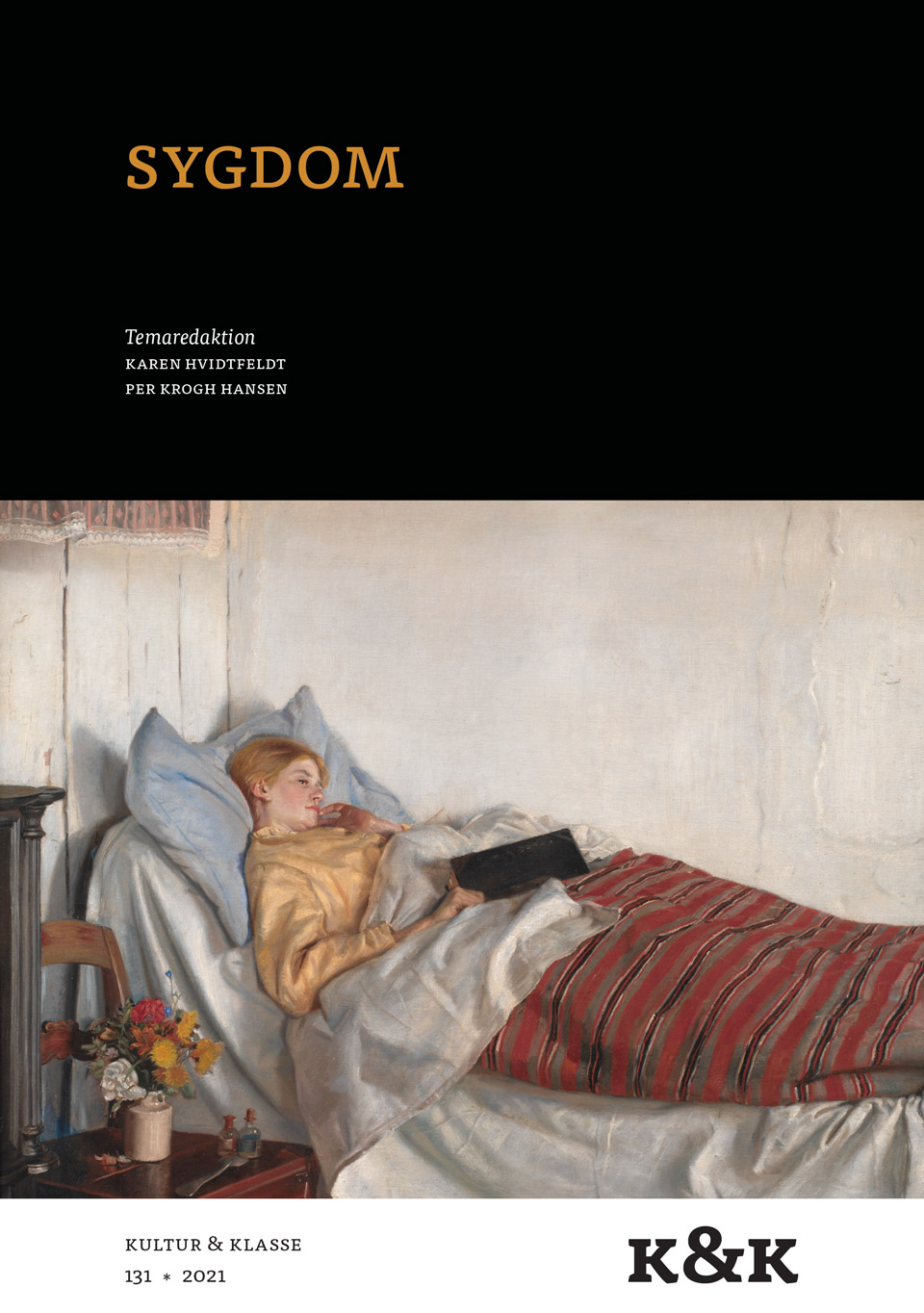Apostrofere den levende
Den pårørendes vitnemål om autisme i Olaug Nilssens Tung tids tale
DOI:
https://doi.org/10.7146/kok.v49i131.127483Nøgleord:
apostrophe, autism, caretaker literature, contemporary, Norwegian literature, illness narrativesResumé
Olaug Nilssen’s Tung tids tale (2017) is a novel about speaking to and for the disabled and disarticulate child in the role as mother and caregiver. Olaug, the narrator, tells the story of her son Daniel’s regressive autism and of the challenges she meets as she tries to mediate between him and the outside world, in particular health personnel and other professional caregivers. The narration is directed towards Daniel himself, addressed as ”you”. Because Daniel is unable to use verbal language and reply, the address resembles the figure of the apostrophe. The communication circuit it generates is triangulated, involving both the ”I” that sends the message, the unresponsive ”you” who is unable to respond to it, and a third party intended to overhear it – in this case the implicit or historical readers of the text. In the article the functions of this address is explored in the light of how the novel thematizes caregiving as an act of witnessing. I argue that the apostrophic address produces an alternative to the novel’s narrative through the establishment of an aesthetic and rhetorical event constituted by the communicative situation itself. The address thus provides a formal way of handling the ethical and existential dimensions connected to Olaug’s role as caregiver and narrator in a text that speaks both for and to her son.
Referencer
Block, Elizabeth. ”The Narrator Speaks: Apostrophe in Homer and Vergil”. Transactions of the American Philological Association 112 (1982): 7–22.
Bitsch, Anne. Brev til en ufødt datter – om frihet, sex og søsterskap. Oslo: Spartacus, 2018.
Bondevik, Hilde og Knut Stene-Johansen. Sykdom som litteratur: 13 utvalgte diagnoser. Oslo: Unipub. 2011.
Brageprisen. ”Tung tids tale”. 2017: https://brageprisen.no/brageprisen/brageprisen-2017/
Charon, Rita. ”The patient-physician relationship. Narrative medicine: a model for empathy, reflection, profession, and trust.” JAMA 286 15 (2001): 1897–1902. doi:10.1001/jama.286.15.1897
Culler, Jonathan. The Pursuit of Signs. London og New York: Routledge, 2001 [1981]. 149–171. doi:10.4324/9780203996157.
Culler, Jonathan. Theory of the Lyric. Cambridge og London: Harvard University Press, 2015. doi:10.4159/9780674425781.
Felski, Rita. Uses of Literature. Oxford: Blackwell, 2008.
Fineman, Martha A. ”Equality, autonomy, and the vulnerable subject in law and politics”. Vulnerability: Reflections on a new fundamention for law and politics. Red. M. A. Fineman og A. Grear. New York: Taylor & Francis, 2013. 13–27.
Hacking, Ian. ”How we have been Learning to Talk about Autism: A Role for Stories”. Metaphilosophy 40 3-4 (2009): 499–516.
Kacandes, Irene. ”Narrative apostrophe: reading, rhetoric, resistance in Michel Butor’s ‘La Modification’ and Julio Cortazar’s ‘Graffiti’.” Style 28 3 (1994): 329–349. doi: 10.2307/42946255
Knausgård, Karl Ove. Om høsten / Om vinteren / Om våren / Om sommeren. Oslo: Forlaget Oktober, 2015–2016
Korsten, Frans-Willem. ”Apostrophe, witnessing and its essentially theatrical modes of address: Maria Dermôut on Pattimura and Kara Walked on the New Orleans Flooding.” AI & Society 27 (2012): 13–23. doi:10.1007/s00146-011-0331-9
Loftis, Sonya. Imagining Autism: Fiction and Stereotypes on the Spectrum. Indiana: Indiana University Press, 2015.
McKechnie, Claire Charlotte. ”Anxieties of communication: the limits of narrative in the medical humanities.” Medical Humanities 40 (2014): 119124. doi:10.1136/medhum-2013-010466
Murray, Stuart. Representing Autism: Culture, Narrative, Fascination. Liverpool: Liverpool University Press, 2008.
NHI - Norsk Helseinformatikk AS. ”Barneautisme – en oversikt”. 21.01.2020: https://nhi.no/sykdommer/barn/autisme/autisme-oversikt/
Nilssen, Olaug. Till Daniel. Oversatt av Joar Tiberg. Stockholm: Albert Bonniers förlag.
Nilssen, Olaug. Tung tids tale. Oslo: Samlaget, 2017.
Nilssen, Olaug. ”Sorg og song”. Vagant 11. juli 2016: http://www.vagant.no/sorg-og-song/
Olsson, Ulf. Silence and Subject in Modern Literature: Spoken Violence. Basingstoke: Palgrave Macmillan, 2013.
Richardson, Alan. ”Apostrophe in Life and in Romantic Art: Everyday Discourse, Overhearing, and Poetic Address.” Style 36 3 (2002): 363-385.
Simonhjell, Nora. ”Å fortjele eller bli fortalt: Ein analyse av Olaug Nilssens Tung tids tale (2017) ”. Religiøst medborgerskap: Funksjonshemming, likeverd og menneskesyn. Red. I.M. Lid og A. R. Solevåg. Oslo: Cappelen Damm Akademisk, 2020. 175–192. doi:10.23865/noasp.100.ch8
Strawson, Galen. ”Against Narrativity”. Ratio 17 4 (2004): 428-452. doi:10.1111/j.1467-9329.2004.00264.x
Vaage, Lars Aamund. Syngja. Oslo: Forlaget Oktober, 2012.
Vaage, Lars Aamund. Sorg og song. Oslo: Forlaget Oktober, 2016.
Vesaas, Halldis Moren. Tung tids tale. Dikt. Oslo: Aschehoug, 1945.
Woods, Angela. ”The Limits of Narrative: Provocations for the Medical Humanities”. Medical Humanities 37 (2011): 73-78. doi:10.1136/medhum-2011-010045
Ørjasæter, Tordis. Kjærligheten har sitt eget språk. En mors fortelling. Oslo: Kagge Forlag, 2017.
Downloads
Publiceret
Citation/Eksport
Nummer
Sektion
Licens
Tidsskriftet følger dansk ophavsret.





